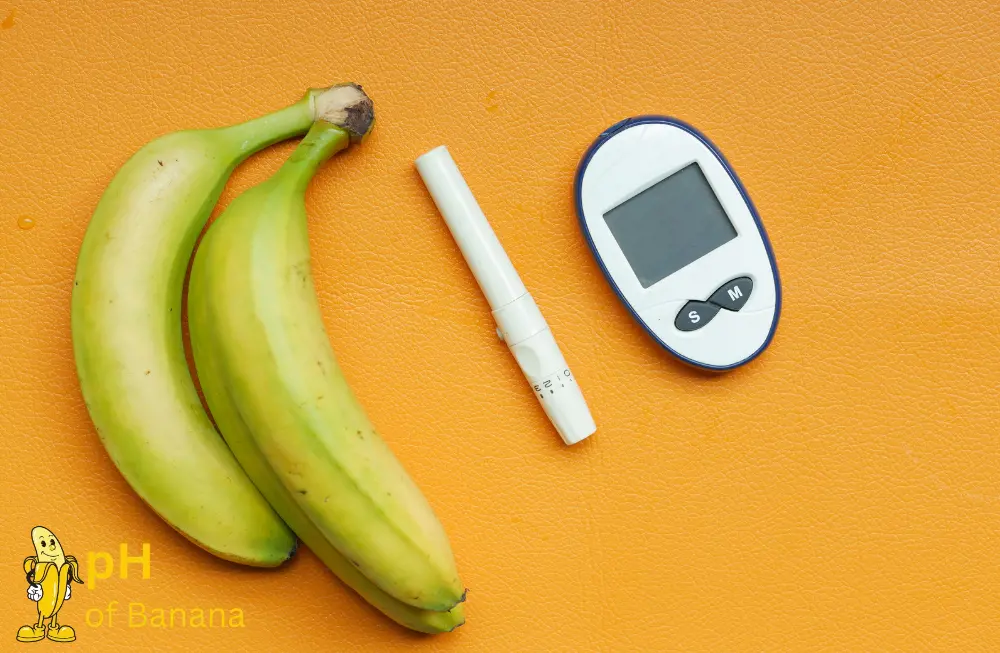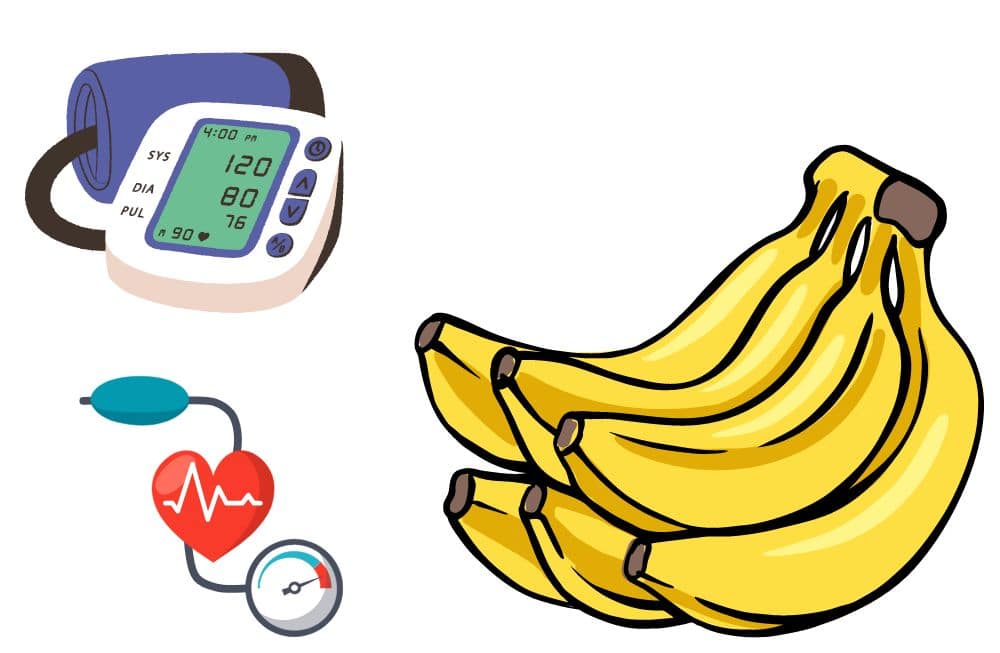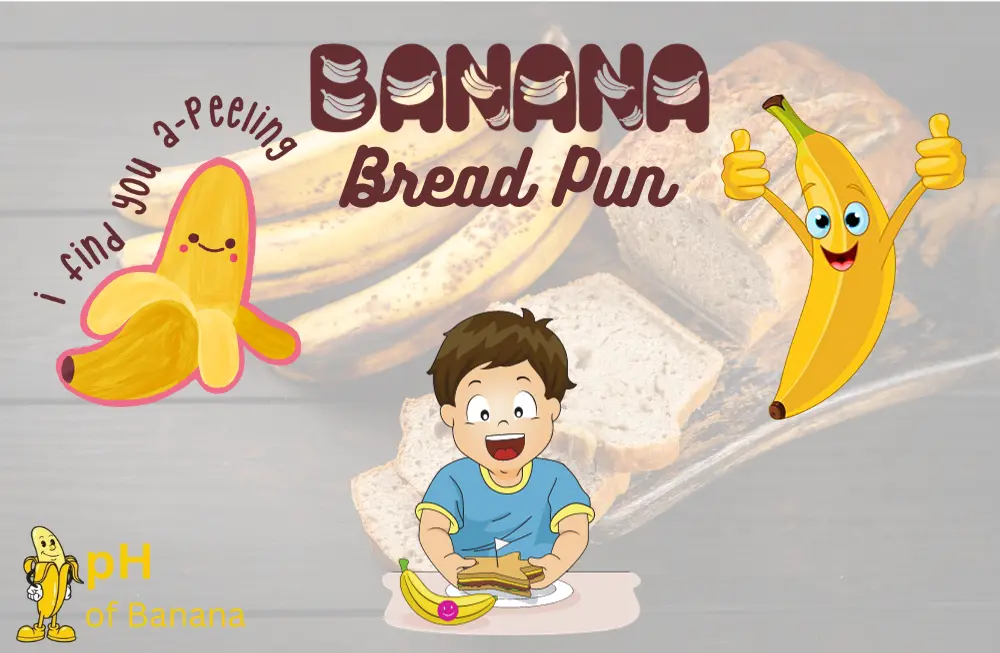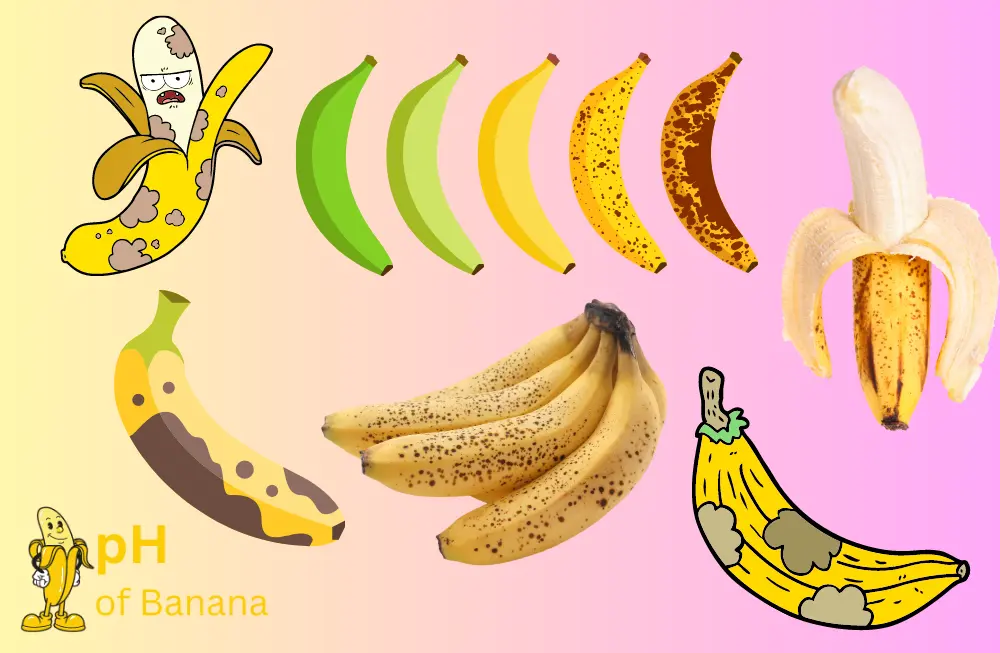The connection between Bananas and Diabetes is quite complex but enchanting. Bananas, a fruit enjoyed worldwide, are popular for their nutritional benefits. But how do these yellow powerhouses fare when it comes to diabetes? This article will help to untangle this complex relationship, making it easy to understand.
The Nutritional Profile of Bananas
The Carbohydrate Content in Bananas (Green Bananas)
Bananas are tasty, but enjoying this sweet fruit is not always so simple for some folks. Take diabetics, for example. Bananas have a good amount of carbs, with a medium-sized banana packing about 27 grams. That’s nearly the same as a slice of bread! Now, carbs aren’t bad, but for diabetics, they can be tricky to manage.
When you eat carbs, your body breaks them down into glucose. This makes your glucose levels rise. A banana on its own can cause glucose to spike pretty fast. Not ideal if you’re trying to keep things balanced! But bananas aren’t just all carbs and sugar. They have some things going for them too.
Bananas have a low glycemic index of 51. This means they don’t cause glucose to increase at super-fast speeds like other foods. The fiber and resistant starch in bananas help slow down the absorption process. This gives the body more time to control glucose levels.
Adding protein to a banana can also help maintain steady glucose. A smear of peanut butter, a spoonful of Greek yogurt, or some nuts are all easy ways to enjoy a banana while keeping glucose friendly.
Research also shows the potassium in bananas may increase insulin sensitivity. This helps the insulin work more effectively to remove glucose.
The Fiber in Bananas
Bananas often get a bad rap for being chock-full of sugar and carbs. But here’s something that may surprise you about this yellow fruit—bananas are also packed with fiber, especially the soluble kind!
I know what you’re thinking…fiber sounds boring. But getting enough fiber in your diet is vital for digestion, heart health, stabilizing glucose levels, and more. The great thing about soluble fiber is that it forms a gel-like texture when mixed with liquid. This slows down the absorption of nutrients into the bloodstream. In bananas, the soluble fiber slows the absorption of sugar.
This delayed absorption is great news if you’re diabetic or just want to keep your blood sugar levels nice and steady. When you eat a banana, the fiber ensures those sugars don’t get dumped all at once into your blood. Instead, it’s a gradual release that your body can easily handle.
One medium banana serves up around 3 grams of fiber. That’s about 10% of your recommended daily value. Plus, unripe bananas contain resistant starch, another type of soluble fiber that resists digestion. This also helps moderate blood sugar levels after a banana snack or meal.
Vitamins and Minerals in Bananas
Fruits are more than just a flavorful delight. They are a source of vital vitamins and crucial minerals our bodies require. In terms of important nutrients, bananas are rich in health benefits.
The content of bananas is about 12% of your daily value of potassium. This mineral is crucial for heart health, fluid balance, and keeping muscles and nerves firing on all cylinders. Bananas are also an excellent source of vitamin B6, and vitamin C. Vitamin B6 helps the body convert food into energy and aids in red blood cell production. Vitamin C boosts immunity, acts as an antioxidant, and helps absorb other key minerals.
Other vital nutrients found in bananas include magnesium and copper. Magnesium plays a role in over 300 different enzyme reactions in the body to keep things running smoothly. Copper helps form red blood cells, maintains nerve cells, and improves immune function. Smaller banana have more nutrition value than large banana.
Understanding People with Diabetes (Can Diabetics eat bananas?)
Type 1 and Type 2 Diabetes (People with Diabetes)
Diabetes is a health condition where your blood sugar runs too high. But not all diabetes is the same. There are two main types—Type 1 and Type 2.
With Type 1 diabetes, the body stops making insulin altogether. Insulin is the hormone that ushers sugar from your blood into your cells for energy. So without insulin, blood sugar has nowhere to go and stays high. Type 1 often starts when people are young, even kids.
In Type 2 diabetes, the body still makes insulin. The problem is the body’s cells have stopped responding to it properly. This is called insulin resistance. Blood sugar still can’t get into cells and circles around in the blood at unhealthy levels. People with Type 2 diabetes tend to develop in adults over 45, though younger folks can get it too. So, type 2 diabetic people can have bananas in their meals or lunch!
Regardless of your type, what you eat plays a big role in controlling diabetes. A healthy diet helps keep blood sugar in check and prevents complications. Work with your doctor to find the right eating plan for you.
Benefits of Eating Banana: The Importance of Diet
Want to get those blood sugar levels under control? What you eat makes a huge difference when you have diabetes. Diet is key for keeping blood glucose steady and avoiding spikes.
The healthiest diabetes diets focus on fiber from fruits, veggies and whole grains. The fiber helps slow the absorption of sugars into your blood – keeping levels even. These diets also include lean protein like fish, chicken, beans, or tofu. Protein provides energy without spiking blood sugar. Complex carbs from whole grains, oats and starchy veggies are preferred over simple carbs like white bread or sugary snacks.
Now, where do bananas fit into a healthy diabetes diet? As a fruit full of fiber, bananas can be a nutritious choice. The fiber balances out the natural sugars. But portion size still matters. Moderation is important when incorporating sweet fruits into your meal plan.
Glycemic Index (GI) and Bananas (Banana Good for Diabetes?)
Ripe vs. Unripe Bananas: GI Differences
If you’re diabetic, you’ve probably heard about the glycemic index or GI. This measures how different foods impact your blood sugar. Foods are ranked from low to high GI. Low GI foods cause blood sugar to rise gradually, while high GI foods lead to raise blood sugar. This can cause high blood sugar. Eventually, that leads to high blood pressure.
The ripeness of bananas affects their GI. Ripe, yellow bananas have a higher GI. They cause a faster increase in glucose compared to unripe, greener bananas.
This is because unripe bananas have more resistant starch. This starch takes longer for the body to break down into carbohydrates. With a lower GI, greener bananas don’t overwhelm the body with carbs too quickly.
So if you’re picking bananas with diabetes in mind, go for the green ones! The lower GI means a slower, steadier rise in glucose when you eat it. Portion size still matters, but an unripe banana is better than ripe.
Balancing GI in a Diabetic Diet
When it comes to the glycemic index, balance is key for diabetes diets. You don’t need to avoid high-GI foods like ripe bananas completely. Instead, combine them with low-GI options to balance out the blood sugar impact.
For example, pairing a ripe banana with nuts or yogurt can moderate that banana’s high GI. The nuts and yogurt take longer to digest, slowing down the absorption of sugars from the banana. This helps prevent sharp glucose spikes. The goal is to create meals that mix high and low-GI foods together. A ripe banana on its own may be too much, but together with low-GI foods, it can be part of a diabetes-friendly diet.
It’s all about balance – not totally cutting out foods but combining them thoughtfully to maintain steady glucose levels. This helps to lower blood pressure. Work with your dietitian to build meals that account for GI without being too restrictive. Moderation and balance are key for healthy diabetes diet planning.
How Fiber in Bananas Affects Blood Sugar Levels
Bananas can seem like a carb bomb, but they actually contain helpful fiber too. The fiber in bananas slows down the digestion of carbohydrates. Even though bananas are sweet, their fiber content keeps the natural sweetness from being absorbed immediately.
This means that bananas don’t produce the same rapid rise in blood sugar as other sugary foods. We all know that taking a high amount of sugar rich foods can cause your blood sugar high. The fiber blunts the impact of natural sweetness. While portion sizes still matter, the fiber in bananas helps control the blood glucose response.
The fiber makes bananas a healthier fruit choice as part of a diabetes diet. Their fiber content allows for gradual absorption, avoiding drastic spikes and dips in blood glucose levels. Bananas and fiber go hand in hand for better blood sugar management. Thus they have lower sugar content compared to other fruits.
The Role of Portion Size
How Many Bananas is Too Many?
Bananas can be part of a healthy diabetes diet, but how many are too many? Moderation matters when it comes to fruit and blood sugar control.
Downing bananas by the bunch likely means you’re getting way too much sugar and calories. That’s risky business for diabetes management. As a general guideline, one medium banana a day is a reasonable amount for most people with diabetes. This portion provides vitamins, minerals, fiber and some sweetness without going overboard on sugar.
But every diabetic is different, so talk to your doctor or dietitian. They can help determine the right banana balance for your specific dietary needs and blood sugar goals. Some people may be able to enjoy more, while others need to scale back.
You can eat bananas if you have diabetes. The amount of sugar in bananas varies. Green bananas contain less sugar. But be mindful of portions and aim for moderation. Chat with your healthcare team to decide how many bananas fit into your nutritional plan.
Can you eat bananas by following Diabetic Diet?
Pairing Bananas with Other Foods
Wondering how to enjoy bananas without spiking your glucose? The secret is pairing them with foods that balance out their effect.
Protein foods are a great match for bananas. Try eating a banana with nuts, peanut butter, cheese sticks, or Greek yogurt. The protein helps slow down the absorption of sugar from the banana into your bloodstream. This prevents a rapid rise in glucose levels.
Healthy fats like avocado or olive oil on a banana can work similarly. They slow digestion, so the banana’s sugars are released more gradually.
There are endless combinations you can try! A banana with nut butter on whole grain toast, sliced bananas on oatmeal with walnuts, or a banana with almond milk and chia seeds. Get creative with pairings that please your tastebuds while keeping glucose in check.
The right pairings can allow you to enjoy bananas without the glucose rollercoaster. Try some balanced banana combos today for a sweet treat that plays nice with diabetes management.
Creative Banana Recipes for Diabetic Diets
As a versatile fruit, bananas can be used in all sorts of diabetes-friendly recipes. With a little creativity, you can enjoy the sweetness of bananas without negatively impacting your glucose levels.
Try slicing a banana to top your morning oatmeal or whole-grain cereal. The oats or cereal fiber will help balance the banana’s natural sugars. You can blend bananas with plain Greek yogurt and cinnamon for a tasty dip or spread.
Make a quick smoothie by mixing bananas, leafy greens, almond milk and chia seeds in a blender. The greens and seeds provide extra nutrition without dramatically increasing glucose.
Stir banana slices into plain yogurt with walnuts and cinnamon for a simple diabetic-friendly dessert. Or blend it into homemade ice cream made with coconut milk and vanilla.
People with Diabetes Eat Bananas: The Risks and Benefits
Balancing Nutrients and Blood Sugar
As a versatile fruit, bananas can be used in all sorts of diabetes-friendly recipes. With a little creativity, you can enjoy the sweetness of bananas without throwing your glucose out of whack.
Try slicing up a banana to top your morning oatmeal or whole-grain cereal. The oats or cereal fiber will help balance the banana’s sugars. You can blend bananas with plain Greek yogurt and cinnamon for a tasty dip or spread.
Make a quick smoothie by mixing bananas, leafy greens, almond milk and chia seeds in a blender. The greens and seeds provide extra nutrition without spiking glucose.
Stir banana slices into plain yogurt with walnuts and cinnamon for a simple diabetic-friendly dessert. Or blend it into homemade ice cream made with coconut milk and vanilla.
Potential Risks of Eating Bananas for Diabetics
Bananas can be a healthy addition to a diabetic diet, but they aren’t risk-free. Some people may experience higher-than-expected glucose rises after eating them. So it’s important to monitor how your own body responds to bananas.
Why the varying response? It depends on the individual. Factors like insulin resistance, medication dosages, and how well diabetes is controlled can all impact glucose reactions. What spikes one person’s levels may be just fine for another.
To play it safe, check your glucose periodically after eating bananas when you first incorporate them. See how much and how quickly they impact you. If you notice larger spikes than desired, scale back your portion sizes or frequency.
Some people with diabetes tolerate bananas without issue, while others have to be more cautious. Work with your healthcare provider to determine if bananas present extra risks for your glucose management.
Bananas and Other Fruits
Comparing Bananas to Other Fruits: The Diabetes Perspective
If you have diabetes, you’ve probably wondered how bananas compare to other fruits. Which ones are best for keeping glucose levels in check? Let’s look at some key comparisons.
Bananas have a moderate glycemic index, or GI, rating. Their carb content per serving is similar to other fruits. However, berries like strawberries and blueberries have a lower GI. This makes them less likely to spike glucose.
Apples are another good option. They’re high in fiber which slows the absorption of their natural sugars. Apples have a lower GI than bananas as well.
While bananas can be a good choice in moderation, lower GI fruits like berries and apples may be safer options for some people with diabetes. Their slower digestion provides better glucose control.
No need to shun bananas completely, but be mindful of portions. Pair them with proteins or healthy fats to balance their glycemic effect. Talk to your dietitian about the best fruit choices for your diet and diabetes management.
Conclusion
Yes, diabetics can enjoy bananas as part of a balanced diet. The key is considering portion sizes and pairing bananas with foods that help moderate blood sugar response. As with any dietary changes, individuals should consult their healthcare providers to tailor dietary recommendations to their specific needs.
FAQs
Can people with diabetes eat bananas?
Yes, people with diabetes can eat bananas. However, they should account for the carbohydrate content of the banana in their meal plan to maintain stable glucose levels.
How do bananas affect blood glucose levels?
Bananas contain carbohydrates that the body breaks down into glucose. However, they also contain fiber, which slows absorption and moderates glucose response.
Are there any risks for diabetics in eating bananas?
The main risk for diabetics eating bananas is potential glucose elevation. Individuals with diabetes must monitor their glucose response to bananas and adjust intake as necessary.
How many bananas can a diabetic eat in a day?
The number of bananas a person with diabetes should eat depends on their individual carbohydrate goals and how their glucose responds to bananas. Generally, one medium banana a day should be safe for most people with diabetes.
What are the best ways to incorporate bananas into a diabetic diet?
Pairing bananas with foods high in protein or healthy fats can slow the release of carbohydrates, preventing sudden spikes. Adding banana slices to whole-grain cereals or using them in low-sugar smoothies are some ways to incorporate bananas into a diabetic diet.







![Substitutes For Banana [ 10 Great Alternatives!] 8 Substitutes For Banana](https://phofbanana.com/wp-content/uploads/2023/06/Substitutes-For-Banana.webp)